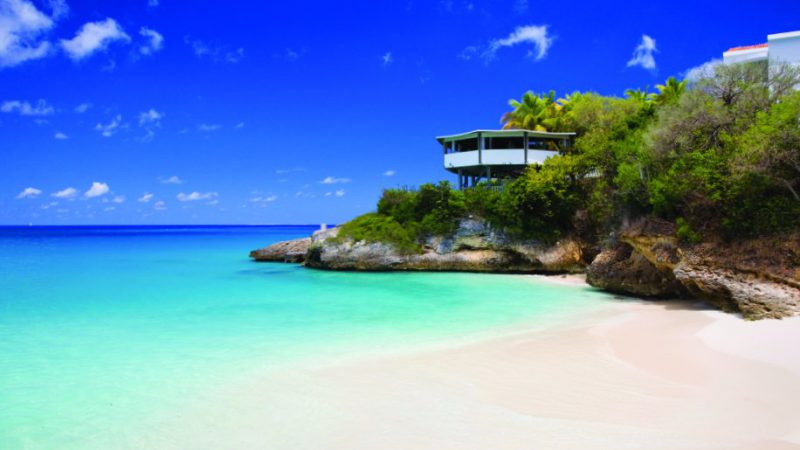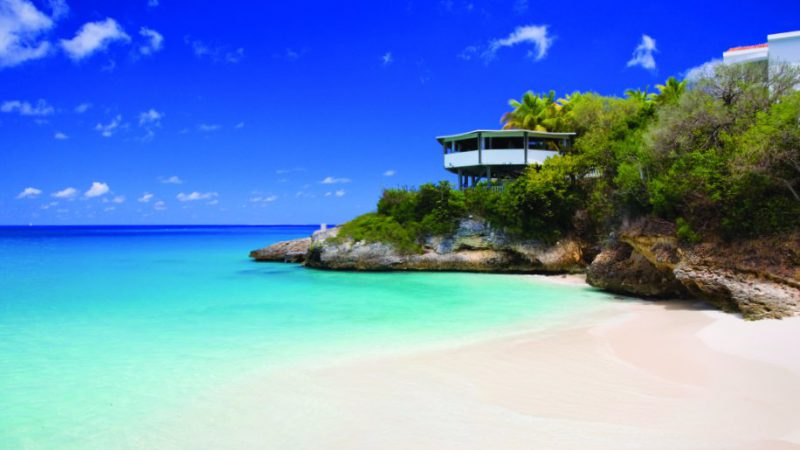Calm Waters
As destructive as they were, the Caribbean hurricanes of 2017 provide a chance for the islands to rebuild and renew
June 1, 2019


At first it seems like just another convivial ferry crossing in the Caribbean. Tourists are lapping up the sunshine, a cheery crew dispenses beers and rum punches, Bob Marley’s singing “Coming In From the Cold.” Yet as we sail out of Simpson Bay Lagoon in St Maarten, bound for the paradise beaches of Anguilla, I sense things aren’t quite right. Why don’t those yachts have masts? What’s that shipping container doing in the water? How does a car get so mangled?
This is the grotesque debris that lingers from the onslaught of Irma, the Category Five hurricane that stormed across the northern Caribbean on September 6, 2017, causing more than 40 fatalities and $14.8 billion worth of damage. Incredibly, some 12 days later, the equally strong Hurricane Maria brought a similar misery to the south, pounding Dominica, the US Virgin Islands and Puerto Rico (third-strongest storm to hit US), where just under 3,000 people died.
It was a devastating double tragedy for the region, but as the Caribbean Tourism Organization points out, more than 70 percent of it remained open for business, including destinations such as Barbados, Jamaica, Grenada and St Lucia. Down through the centuries, however, every island here has felt the sour kiss of malevolent weather, and it says everything that the word “hurricane” means in these tropical climes – derived from “hurakan,” meaning “god of the storm” in the language of the indigenous Taino people.
No one doubts there are more 185 mph winds and terrifying storm surges to come, and climate change seems to be making things worse. “The warmer the upper ocean, the more powerful a hurricane can become,” a study by the Pacific Northwest National Laboratory concluded in May last year.
“Irma was so powerful,” sighs Kenroy Herbert, an Anguillian who runs a lifestyle management company on this tiny British Overseas Territory. “No one could prepare for something as strong as that.” Every islander here has a tale to tell and it’s a grim montage – children huddled under propped-up mattresses, villagers forming human chains, 4x4s flying through the air.
Tim Foy, governor of Anguilla, had taken up his post only a few weeks before Irma hit. He is proud of the UK government’s response. “We paid for 40 Canadian linesmen to help restore power, and we’ve put close to £70 million ($90 million) into the island’s recovery,” he says.
Foy explains to me how a hurricane is not just about the physical damage that dominates the news reports – there’s the economic loss, too. For a high-end holiday island with a short season such as Anguilla, it was essential to reopen the airport quickly to welcome the private jets that traditionally flock here over Christmas and New Year. A makeshift control tower was ingeniously fashioned out of upended shipping containers, and within a month the vital flights were coming in.
Open for Business
Strange as it seems, such hard blows can have their positive side. Once calm descends, you are left with an unscheduled opportunity to rebuild and improve. This was the case for Cuisinart Golf Resort and Spa on Anguilla’s southwest coast. “We had to close for a year of reconstruction,” says managing director Stephane Zaharia, as he proudly shows me a dazzling all-white beach resort with a host of “new bells and whistles.” These include 91 suites and a state-of-the-art children’s “Splash Pad” playground.
It’s a similar story on the miniscule French playground of St Barths, where Irma’s blasts were so strong that they broke all of the machines for recording wind speed. “I felt I was being suffocated,” recalls Gary Monteremard, a cheery valet working at Hotel Le Toiny. He admits that the ensuing days were “very scary” because of the shortage of food and water.
Now some 20 months later, visitors today will see little sign of damage here. Most hotels have reopened, with only a few, such as Eden Rock and Le Guanahani, taking longer to get back to the superlative standards demanded by their well-heeled customers.
Ironically, while tourism figures on the hurricane-hit islands inevitably took a dent for the 2017-18 winter season, some now boast the most stylish and attractive escapes in the Caribbean. Belmond La Samanna on St Martin, Auberge Resorts’ Malliouhana on Anguilla and Secret Bay on Dominica are some starry examples.
Joint Effort
Another positive legacy is the sense of community that is born when islanders come together to face a crisis. Within hours, fishermen from Guadeloupe had launched their boats to speed essential supplies to St Barths, while Anguillians proudly relate how they didn’t wait for outside help but just got straight on with the clearing up.
Nature seemed to offer support, too. On Dominica, where Maria stripped the trees as bare as the bristles on a toothbrush, islanders were amazed at how quickly the rainforest burst back into life, and there was joy when the endangered sisserou, an endemic parrot that forms the centerpiece of their national flag, was finally sighted 13 hours after the storms had passed.
Today, tourism is booming in many parts of the Caribbean. In February the Anguilla Tourist Board announced that visitor numbers had hit a 26-year high, while Antigua, Jamaica and Grenada have also reported record growth.
It was a great blessing when the 2018 hurricane season passed without further catastrophe, and the chance of more natural disasters has not stifled the cranes swinging over new projects such as Kempinski’s 160-room Cabrits Resort in Dominica, which is due to open late this year, or to deter major carriers such as American Airlines and Delta Air Lines from launching new flights.
Contingency Plans
Is the Caribbean ready for the next big one? I witness preparations at many levels, from back-up power supplies being installed for Anguilla’s critical services to a hotel in St Kitts conducting a practice drill for tsunami evacuation.Three months ago, Jamaica’s tourism minister, Edmund Bartlett, opened a new Global Tourism Resilience and Crisis Management Centre in Kingston that will face up to region-wide challenges such as climate change, disaster management and cybersecurity. It is a recognition that no island can cope with such issues in isolation, for while those that are wealthy or have long-standing ties with other countries have been able to rebuild fast, elsewhere the road to full recovery is looking long and hard.
Puerto Rico is still struggling, while Barbuda, Antigua’s sister isle, was caught in the eye of Irma, resulting in the complete evacuation of its 1,800 residents. It was a year before they could return, and even now its settlements are a jumble of decapitated buildings and yards festooned with tents and tarps bearing tell-tale names like USAID, World Food Program and Samaritan’s Purse.
All of this could be depressing, yet I’m struck by the warmth and resilience of its islanders, their lifestyle still rich with the music, color and charisma that makes so many of us visit the Caribbean time and time again.“It took us eight months to get it back in shape,” says Barbara Petit, the French co-owner of Barbuda Belle, a barefoot luxury escape on the north coast. After 27 years here and with 14 local staff to support, even a mighty puff like Irma wasn’t going to make her give up.
As we stroll along the blissfully deserted beach, she sees me staring with astonishment at a strange, rosy glow beneath our feet. “We didn’t have pink sand here before the hurricane,” Petit explains, and it’s impossible not to see this enchanting blush, which is created from millions of shell fragments, as just another form of rainbow. Irma was a beast, for sure, but she also left a little beauty.




